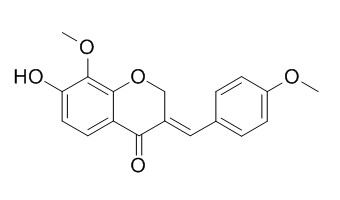8-Methoxybonducellin
8-Methoxyisobonducellin shows a inhibitory effect on Staphylococcus aureus, Klebsiella Peneumoniae, Beta streptococcus and Aeruginosus bacillus.
Inquire / Order:
manager@chemfaces.com
Technical Inquiries:
service@chemfaces.com
Tel:
+86-27-84237783
Fax:
+86-27-84254680
Address:
1 Building, No. 83, CheCheng Rd., Wuhan Economic and Technological Development Zone, Wuhan, Hubei 430056, PRC
Providing storage is as stated on the product vial and the vial is kept tightly sealed, the product can be stored for up to
24 months(2-8C).
Wherever possible, you should prepare and use solutions on the same day. However, if you need to make up stock solutions in advance, we recommend that you store the solution as aliquots in tightly sealed vials at -20C. Generally, these will be useable for up to two weeks. Before use, and prior to opening the vial we recommend that you allow your product to equilibrate to room temperature for at least 1 hour.
Need more advice on solubility, usage and handling? Please email to: service@chemfaces.com
The packaging of the product may have turned upside down during transportation, resulting in the natural compounds adhering to the neck or cap of the vial. take the vial out of its packaging and gently shake to let the compounds fall to the bottom of the vial. for liquid products, centrifuge at 200-500 RPM to gather the liquid at the bottom of the vial. try to avoid loss or contamination during handling.
Appl. Sci. 2021, 11(10),4666.
Plant Physiol Biochem.2019, 144:355-364
Oncotarget.2017, 8(53):90925-90947
Nutrients.2024, 16(15):2518.
Vet World.2023, 16(3):618-630.
Chem Pharm Bull (Tokyo).2019, 67(11):1242-1247
Acta Pharmaceutica Hungarica2016, 86:35-40
Int J Mol Sci.2021, 22(9):5012.
Int. J of Herbal Med.2023, 11(1): 06-14
LWT-Food Science and Technology2017, 75:488-496
Related and Featured Products
Zhongguo Zhong Yao Za Zhi. 2012 Jul;37(14):2105-7.
Chemical constituents and antibacterial activity contained in Caesalpinia millettii.[Pubmed:
23126193]
To study chemical constituents contained in roots of Caesalpinia millettii by HPLC.
METHODS AND RESULTS:
Six homoisoflavonoids were identified by spectroscopic data and physicochemical property as eucomin (1), intricatinol (2), 8-Methoxybonducellin (3), bonducellin (4), 8-methoxyisobonducellin (5) and 3-(4-methoxybenzyl) -5, 7-dimethoxychroman-4-one (6). All compounds were separated from the root of this genus for the first time. An antibacterial screening was made on eight monomeric compounds.
CONCLUSIONS:
Among them, 8-methoxyisobonducellin, intricatinol, bergenin, hyperoside and 11-O-galloylbergenin showed a inhibitory effect on Staphylococcus aureus, Klebsiella Peneumoniae, Beta streptococcus and Aeruginosus bacillus.
Phytochemistry.1987;26(6):1831-1833.
Homoisoflavonoids from Caesalpinia sappan.[Reference:
WebLink]
METHODS AND RESULTS:
Three new homoisoflavonoids, 7-hydroxy-3-(4′-hydroxybenzylidene)-chroman-4-one, 3,7-dihydroxy-3-(4′-hydroxybenzyl)-chroman-4-one and 3,4,7-trihydroxy-3-(4′-hydroxybenzyl)-chroman were isolated from the dried heartwood of Caesalpinia sappan, together with the known compounds 4,4′-dihydroxy-2′-methoxychalcone, 8-Methoxybonducellin, quercetin, rhamnetin and ombuin.



